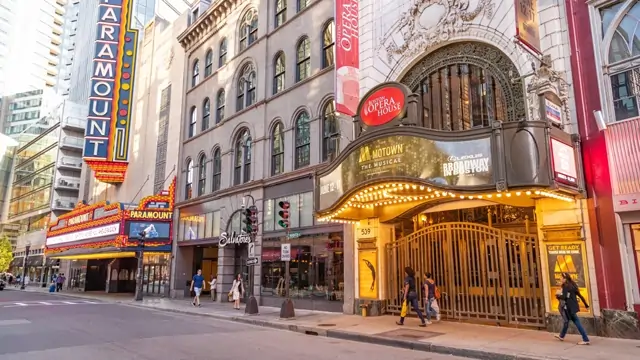Nestled in the heart of Boston, the Boston Opera House is a testament to the city’s rich cultural heritage and commitment to the performing arts. With its opulent interiors and state-of-the-art facilities, this majestic venue continues to captivate audiences and artists alike, fostering a love for opera and live performances that transcends generations.

A Storied Past
The Boston Opera House was originally opened in 1928, a creation that mirrored the grandeur and ambition of the Roaring Twenties. Designed by the renowned architect Thomas W. Lamb, it was a palace for the people, offering a space where the arts could flourish. Over the decades, it has undergone numerous renovations to restore its original splendor and update its amenities, ensuring it remains a premier destination for entertainment in Boston.
Architectural Marvel
Upon entering the Boston Opera House, visitors are immediately struck by the lavish décor adorning its halls and auditorium. Every detail contributes to an atmosphere of elegance and grandiosity, from the ornate chandeliers to the intricate frescoes. This attention to detail and preservation of historical elements make the opera house not just a venue for performances but a work of art in its own right.
A Hub for the Performing Arts
The Boston Opera House is renowned for hosting various performances, from grand operas to contemporary ballets and Broadway shows. It serves as the home for the Boston Ballet, showcasing its annual, enchanting performance of “The Nutcracker,” a holiday tradition for many regional families. The opera house’s state-of-the-art acoustics and spacious stage make it an ideal venue for artists to deliver their best performances, leaving audiences spellbound.
Accessibility and Engagement
Understanding the importance of accessibility, the Boston Opera House offers various services to ensure everyone can enjoy its offerings. From audio-described performances for the visually impaired to sign-language-interpreted shows, it strives to be inclusive. Additionally, the opera house runs educational programs and tours, aiming to ignite a passion for the arts in people of all ages and backgrounds.
A Commitment to Excellence
The Boston Opera House prides itself on the quality of its productions and the excellence of the visitor experience. From the moment patrons step through its doors, the venue’s dedication to making each visit memorable meets them with impeccable service. Whether it’s the comfort of the seating or the quality of the refreshments.
Looking to the Future
As the Boston Opera House looks towards the future, it embraces innovation while honoring its historical legacy. By hosting a diverse range of performances and engaging with the community, it aims to remain a central figure in Boston’s cultural landscape. The opera house stands not just as a venue for entertainment. But as a symbol of the city’s enduring love for the arts.
Conclusion
The Boston Opera House is more than just a building; it is a living, breathing entity that encapsulates the spirit of Boston. It represents a bridge between the past and the present. A place where people cherish the arts and foster their continued thriving. For anyone visiting Boston. A trip to the opera house offers a unique glimpse into the city’s soul, making it a must-see destination for culture lovers everywhere.
FAQs
1. What performances can I see at the Boston Opera House?
At the Boston Opera House, audiences can enjoy diverse performances, including grand operas, ballets, Broadway tours, and concerts. It is the home of the Boston Ballet, particularly known for its annual performance of “The Nutcracker.” The venue also hosts a variety of contemporary shows and classical concerts, offering something for every taste.
2. How can I purchase tickets for a show at the Boston Opera House?
Tickets for performances at the Boston Opera House can be purchased through the official opera house website, over the phone, or at the box office. Buying tickets in advance is advisable as many shows sell out quickly. The website also provides information on seating charts, pricing, and any available discounts.
3. Are there any accessibility services provided?
Yes, the Boston’s Historic Opera Venue is committed to accessibility for all its patrons. It offers various services, including wheelchair-accessible seating, audio-described performances for the visually impaired. And American Sign Language (ASL)-interpreted performances for the deaf and hard of hearing. Please get in touch with the opera house directly or visit their website for more information on accessibility services.
4. Can I take a tour of the Boston’s Historic Opera Venue?
Yes, the Boston’s Historic Opera Venue offers tours with a behind-the-scenes look at the historic venue, including its architecture, history, and operations. The public can access these tours, and they can find dates and times on their website. Additionally, individuals can arrange group tours by contacting the opera house directly.
5. What are the best ways to get to the Boston Opera House?
The Boston Opera House is conveniently located in downtown Boston and is accessible by public transportation, including subway and bus routes. Downtown Crossing (Red and Orange Lines) and Park Street (Green and Red Lines) are the nearest subway stations. If you’re driving, you’ll find several parking garages nearby. But it’s recommended to arrive early as parking downtown can be limited. The opera house encourages public transportation due to its central location.
Read More…
Discover the Top 6 Best Landscape Places in the World
The post Boston Opera House || A Beacon of Culture and History appeared first on Travelstype.

